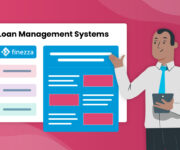It is rare to see that all of the financial holdings of a borrower are in one place. The bulk of the time, they are scattered among various intermediaries and most likely fall within the jurisdiction of ten different regulators.
For instance, a customer can have fixed deposits in three different banks, each under RBI’s purview. They may have mutual funds with one or more asset management companies falling under the overview of SEBI. They can also have life insurance that comes under the ambit of IRDAI.
Accessing data from these dispersed investments and then consolidating it to get a clearer picture of the borrower has two significant issues. One, it is highly cumbersome and time-consuming. Two, it causes a lot of confusion for the customer, leading to a poor loan-taking experience.
That’s why account aggregators, particularly when integrated with a loan management system, are considered game-changers.
What is an account aggregator (AA)?
In simplest terms, an account aggregator obtains all the relevant financial data of a customer, consolidates it and delivers it to a third party. These financial entities are RBI-licensed and have the unequivocal consent of the customer to access and share their data.
For financial information providers (FIP), AAs are beneficial because they reduce manual effort and give complete control over data usage with the flexibility to revoke consent anytime.
For financial information users (FIU), the primary benefit is gaining all data in one easy-to-read format that allows for in-depth analysis.
How connecting an AA to a loan management system impacts you?
The problems that account aggregators solve are real. They are enabling individuals to share their information securely with financial institutions and, in return, get more tailored financial services.
For banks, NBFCs, and other lending institutions, there are plenty of use cases that leverage the AA ecosystem. We’ve spoken of them before. Here we focus solely on how linking an AA to their management system impacts the business for the better.
Earns more customer trust
Building trust in customers is crucial. Integrating an account aggregator with your loan management software strengthens that trust. It does so because a customer can check at any time what information you have (or don’t) about them.
Moreover, AAs follow strict security and privacy policies to ensure that data is shared and accessed by only those authorised. And at all other times, it is encrypted and masked. This generates an even higher degree of trust in borrowers.
Lesser borrower dropouts
Account aggregation aims to reduce paperwork by merging savings and current bank accounts, cash flows, and investments in a single location. Since the effort on the customer’s and lender’s part becomes minimal, the rate of dropouts during the loan application process is reduced.
Further impacting the customer experience is the rapidity with which a loan management system can access all required financial data and assess the credit risk. It considerably quickens the pace, which also lessens the number of borrowers abandoning the loan application.
Automated, comprehensive service
AAs offer the entire financial profile of the customer to a borrower. You gain the whole picture – how one account is related to another, what financial investments they have and where they are. The loan management system can capitalise on this comprehensive information to automate the credit lending workflow.
A secondary benefit here is de-risking the loan books through more personalised loans. The advanced analytics feature of the loan management system can better evaluate a customer because it has access to holistic data.
The risk to lenders is further reduced by constant loan monitoring. Integrating AA with loan management software allows periodic access to financial data. Therefore, a lender can identify ahead of time when a customer shows a possibility of defaulting, controlling their risk. It ensures your NPAs are lowered.
Serving untapped segments
Infosys chairman Nandan Nilekani estimated, “only 8% of Indian small businesses get credit from the banking system. Due to a combination of factors like public sector banks having high NPAs, NBFCs having asset-liability mismatch, the whole thing is gridlocked.”
By adding an AA to the loan management software, lenders can serve underserved segments like MSMEs. Say, for instance, a small vendor requires a loan but lacks financial assets. The vendor also has a low credit history or completely lacks a formal credit record.
Through AA, the loan management software can access cash-flow statements of the vendor to evaluate creditworthiness. Or rely on alternate data like bank statements or tax returns to offer low-cost credit.
In a gist, account aggregators enable you to shift from purely asset-based lending ( which severely limits the number of customers) to cash-flow based lending.
Secure, safer data practices
As technologies evolve, data security and privacy are becoming an all-encompassing issue. Using ad-hoc, unsafe methods to store or share crucial financial information doesn’t cut it anymore.
AAs have strict rules on data privacy and protection. When lenders integrate with an account aggregator, they have to follow the same framework. It guarantees that private information is always protected. Furthermore, the risk of data leaks from sensitive documents shared over emails or snail-mailed to branch offices is greatly diminished.
Better savings
Another impact of connecting a loan management system to an account aggregator is lower loan origination cost. Traditionally, a lender has to employ a substantial number of people to verify the documents submitted by a customer. They also have to digitise the paper documents.
The total cost, including in terms of time taken, is high. Linking with an AA offers electronic submission of financial information that requires no verification. It minimises the time taken to onboard and the associated expenses.
Standardisation of data
Currently, financial information in different organisations is stored and used in various formats. But as more and more players begin to utilise account aggregators, the data will be standardised.
So, in the bigger picture, AA helps convert all financial data into one format and structure. That would aid in faster data transfer, better algorithms in tech solutions like loan management systems or bank statement analysers.
The Takeaway:
The current pool of customers is becoming increasingly confident in allowing FIUs to access their data in exchange for better financial services. Consequently, it behoves lenders to explore new avenues that streamline the loan process.
Relying on methods like scraping online accounts, integrating with employer payroll software, manual uploading of documents to gather all information is inconvenient. More than that, it rarely provides you with the whole picture. On top of it, ascertaining the integrity of those documents is not a simple task.
A loan management system eliminates many of these pain points, but integrating it with an account aggregator can bring a seismic shift. It can democratise lending while ensuring complete privacy and security.
At Finezza, we offer a range of fintech solutions for banks, NBFCs and other institutes, from loan origination system to AA integration. Get in touch to integrate your loan management system with an account aggregator.




Leave a Reply